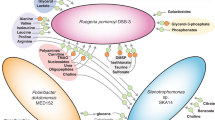Abstract
An Antarctic psychrophilic marine Vibrio species was isolated having the inducible ability to accumulate nonmetabolizable thiomethyl-14C-β-galactopyranoside (14C-TMG) through a galactose permease system. Induction of 14C-TMG uptake was found to have a salinity requirement which was higher than that required for uptake. At the optimum salinity, galactose and fucose were the primary inducers. Lactose produced a comparable induction but only at higher concentrations, whereas glucose did not cause induction. The initial rate of 14C-TMG uptake exhibited saturation kinetics with an apparent Km value of 4.8 x 10−6M. An amino acid, in addition to the inducer, was required for induction which could not be replaced by glycerol or galactose. Evidence is presented which indicates that the uptake of 14C-TMG is energy-dependent and that nutrient availability is more important than salinity for induction and uptake under conditions which would normally be found in the oceanic environment.
Similar content being viewed by others
Literature Cited
Arnaud, P.M.: Adaptations within the Antarctic marine benthic ecosystem. In: Adaptations within Antarctic ecosystems, pp 135–157. Ed. by G.A. Llano. Houston, Texas: Gulf Publishing Co. 1977
Degen, E.T.: Molecular nature of nitrogenous compounds in seawater and recent marine sediments. In: Symposium on organic matter in natural waters, pp 77–99. Ed. by D.W. Hood. College, Alaska: Institute of Marine Science 1970
DeVries, A.L.: Glycoproteins as biological antifreeze agents in Antarctic fishes. Science, N.Y. 172, 1152–1155 (1971)
Drapeau, G.R. and R.A. MacLeod: Na+ dependent active transport of alpha amino isobutyric acid into cells of a marine pseudomonad. Biochem. biophys. Res. Commun. 12, 111–115 (1963)
Fogg, G.E.: The extracellular products of algae. Oceanogr. mar. Biol. A. Rev. 4, 195–212 (1966)
Handa, N.: Dissolved and particular carbohydrates. In: Symposium on organic matter in natural waters, pp 129–148. Ed. by D.W. Hood. College, Alaska: Institute of Marine Science 1970
Jannasch, H.W.: Growth of marine bacteria at limiting concentrations of organic carbon in seawater. Limnol. Oceanogr. 12, 264–271 (1967)
Jones, W.G.M. and S. Peat: Constitution of agar. J. Chem. Soc. 1942, 225–231 (1942)
Litchfield, C.D.: Interaction of amino acids and marine bacteria. In: Estuarine microbial ecology, pp 45–166. Ed. by L.H. Stevenson and R.R. Colwell. Columbia: University of South Carolina Press 1973
—: Numerical taxonomy of heterotrophic bacteria growing in association with continuous-culture Chlorella sorokiniana. Appl. Microbiol. 18, 1044–1049 (1969)
— and G.D. Floodgate: Biochemistry and microbiology of some Irish Sea sediments: II. Bacteriological analyses. Mar. Biol. 30, 97–103 (1975)
Lowry, O.H., N.J. Rosebrough A.L. Farr and R.J. Randall: Protein measurement with the folin phenol reagent. J. biol. Chem. 193, 265–275 (1951)
Novitsky, J.A. and R.Y. Morita: Morphological characterization of small cells resulting from nutrient starvation of a psychrophilic marine vibrio. Appl. envirl Microbiol. 32, 617–622 (1976)
Payne, W.J.: Studies on bacterial utilization of uronic acids. Induction of oxidative enzymes in a marine bacterium. J. Bact. 76, 301–307 (1958)
—: Effects of sodium and potassium ions on growth and substrate penetration of a marine pseudomonad. J. Bact. 80, 696–700 (1960)
Pratt, D. and S. Tedder: Variation in the salt requirement for the optimum growth rate of marine bacteria. In: Effects of the ocean environment on microbial activities, pp 38–45. Ed. by R.R. Colwell and R.Y. Morita. Baltimore: University Park Press 1974
Rhodes, M.E., and W.J. Payne: Further observations on effects of cations on enzyme induction in marine bacteria. Antonie van Leeuwenhoek 28, 302–314 (1962)
——: Influence of Na+ on synthesis of a substrate penetration mechanism in a marine bacterium. Proc. Soc. exp. Biol. Med. 124, 953–955 (1967)
Sieburth, J. McN. and A. Jensen: Production and transformation of extracellular organic matter from littoral marine algae: a resume. In: Symposium on organic matter in natural waters, pp 203–218. Ed. by D.W. Hood. College, Alaska: Institute of Marine Science 1970
Webb, C.D. and W.J. Payne: Influence of Na+ on synthesis of macromolecules by a marine bacterium. Appl. Microbiol. 21, 1080–1088 (1971)
Author information
Authors and Affiliations
Additional information
Communicated by M.R. Tripp, Newark
Technical Paper No. 4911, Oregon Agricultural Experiment Station.
Rights and permissions
About this article
Cite this article
Hayasaka, S.S., Morita, R.Y. Salinity and nutrient effects on the induction of the galactose permease system in a psychrophilic marine vibrio. Mar. Biol. 49, 1–6 (1978). https://doi.org/10.1007/BF00390724
Accepted:
Issue Date:
DOI: https://doi.org/10.1007/BF00390724




